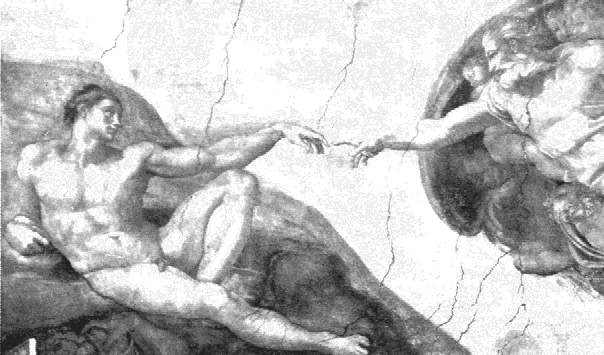
Traditional 19th and 20th century gay male art is often about the magnificent male physique. The appearance of a contemporary alternative to that art in New York and other major art centers is about gay vision and its relationship to gay male sexuality. However, I wonder if the alternative is actually new as claimed by some contemporary critics?1 A look at the art produced by gay male artists makes it clear that there have been alternatives to art about the perfect male body, even as early as the Renaissance. I base my argument in part on a partial list of gay male artists, and in part on looking at the images of painting and sculpture produced by these artists during the past 500 years. I’ve placed each artist in one of two categories; 1) artists who make art about the ideal male body, and 2) artists who make art about a personal vision and its relationship to their sexuality.* I have applied my categorization to all gay male artists on the list even though I know that the conceptualization of and the word, “homosexual” did not exist earlier than 1869, the year in which Karl Maria Kertbeny created his system of human sexuality classification.2 In Kertbeny’s system, men attracted to women are heterosexual, masturbators are monosexualists, and others who engage in anal intercourse are designated as pygists. Kertbeny used his system to classify any/all kinds of human sexuality imaginable, and he did not intend to create the dichotomy, heterosexual versus homosexual that is so prevalent in the contemporary conceptualization of human sexuality.3
Thus, as I look back through time, I know and accept that both Michelangelo, and Leonardo Da Vince fit the contemporary conceptualization of homosexuality, though at the time neither of them knew and understood the possible categorization of human sexuality. Thus, I place both men on my list, Michelangelo in category one, Leonardo Da Vinci in Category two. That placement will be apodictic through the use of examples of both men’s work. First, a look at Michelangelo’s Sistine Chapel Ceiling, specifically “The Creation of Adam,” in which God himself is depicted with a magnificently muscular male human form, despite the fact that he (God) is shown as an old man with a full head of white hair and a white beard. Of course the naked Adam is magnificent if under endowed, a sign of male beauty at the time.4 We are all familiar with Michelangelo’s “David,” for centuries considered to be the epitome of perfected male physique.5 Michelangelo’s women are muscular and rather masculine, seemingly created from a well-muscled male form with a female's head and breasts attached. Look at the muscular arms on the “Delphic Sybil.” 6 It is as though the beautifully constructed arms of an idealized male have been attached to the cloaked female form. Or consider the “Cumaean Sybil,” whose face is certainly not attractive according to contemporary norms, or Renaissance norms, and whose arms are idealized muscular and male in appearance in either case.7 Second, a look at Leonardo Da Vinci’s “St. Jerome” and other works supports the argument that these works offer a more intellectual alternative to Michelangelo’s hugely muscled male forms. In the case of “St. Jerome,” the arms are thin and twisted with age. Jerome’s face is skeletal, sinews stretched ropes to the protruding clavicles with gullies behind.8 “Vetruvius Man,” though Da Vinci was stating his ideal human proportions, is none the less without Michelangelo’s bulging musculature. Instead we find diminutive biceps, slight torso, and old slightly wrinkled face. The much later portrait of “John the Baptist,” is beyond androgynous, with pudgy arms and smooth skin. St. John’s face is also smooth and feminine with the same enigmatic smile possessed by the “Mona Lisa.”10 11 St. John is similar in style and form to Leonardo’s idealized women. Thus, it would seem that both Michelangelo and Leonardo were playing with transgressive images of human gender and sexuality 500 years ago, though neither was in possession of a Twenty-first Century knowledge of human sexuality. Additionally Leonardo's work offers us an alternative to Michelangelo's images of puffed up male musculature.
_____________________________
1 Risemberg, Rafael, “Gay Male Artists Thrive, Evolve: Assessing the current boon of queer exhibits,” New York Blade Online, http://nyblade.com/print.cfm?content_id=5726. November 09, 2007. Viewed Sunday, November 18, 2007, 9:12 A.M. EST.
Trebay, Guy, “Gay Art: A Movement, or at Least a Moment,” New York Times on Line, http://www.nytimes.com/2007/05/06/fashion/06gay.html. May 06, 2007. Viewed, Sunday, November 18, 2007, 8:50 A.M. EST.
* For the actual list as it stands at this time see my entry for November 19, 2007.
2 Wikholm, Andrew, “1869, Kertbeny coins the term ‘Homosexual,’” gayhistory.com, Timeline: Culture and Identity. http://www.gayhistory.com/rev2/factfiles/ff1869b.htm. Copyright 1999. Viewed at 3:21 P.M., EST.
3 Klomp, John, Isaac Stoltzfus: Images about sexuality and Culture. Doctoral Dissertation, NYU, page 5. (2000)
4 Harden, Mark, “The Creation of Adam,” The Artchive, http://www.artchive.com/artchive/M/michelangelo/creation.jpg.html. Copyright? Viewed Wednesday, November 21, 2007, 10:15 A.M., EST.
5 Harden, Mark, “The Delphic Sybil,” The Artchive, http://www.artchive.com/artchive/M/michelangelo/creation.jpg.html, Copyright? Viewed Wednesday, November 21, 2007, 10:15 A.M., EST.
6Harden, Mark, “The Delphic Sybil,” The Artchive, http://www.artchive.com/artchive/M/michelangelo/sibyl.jpg.html. Copyright? Viewed Wednesday, November 21, 2007, 10:15 A.M., EST.
7Harden, Mark, “The Cumaean Sybil,” The Artchive, http://www.artchive.com/ftp_site.htm. Copyright? Viewed Wednesday, November 21, 2007, 10:20 A.M., EST.
8 Harden, Mark, “St Jerome,” The Artchive, http://www.artchive.com/ftp_site.htm. Copyright? Viewed Monday, November 26, 2007, 9:41 A.M., EST.
9 Harden, Mark, “Vetruvius Man,” The Artchive, http://www.artchive.com/ftp_site.htm. Copyright? Viewed Monday, November 26, 2007, 9:41 A.M., EST.
10 Harden, Mark, “John, The Baptist,” The Artchive, http://www.artchive.com/ftp_site.htm. Copyright? Viewed Monday, November 26, 2007, 9:50 A.M., EST.
11 Harden, Mark, “Mona Lisa,” The Artchive, http://www.artchive.com/ftp_site.htm. Copyright? Viewed Monday, November 26, 2007, 10:02 A.M., EST.
No comments:
Post a Comment